The Relationship of the Information Quantity of Urban Roadside Traffic Signs and Drivers’ Visibility Based on Information Transmission
Abstract
1. Introduction
2. Theories and Models
2.1. The Driver’s Information Processing Process
2.2. The Driver’s Visual Recognition Process
2.3. The Traffic Sign Information Elements
- Chinese character: there are 3500 characters in total.
- English character: contains 26 English letters from A to Z.
- Arabic numeral: contains ten numbers from 0 to 9.
- Geometric figure: mainly includes six types, such as squares, circles, equilateral triangles, inverted equilateral triangles, octagons, and forks.
- Color: mainly consists of 11 kinds of color. Such as red, yellow, fluorescent yellow, blue, green, brown, black, white, orange, fluorescent orange, fluorescent yellow-green.
- Pointing symbol: it indicates different direction arrows or guidance symbols, about 30 kinds.
- Graphic or characteristic symbol: there are roughly 50 commonly used graphics and characteristic symbols in traffic signs.
2.4. The Traffic Sign Information Model
3. Methods
3.1. The Experimental Design
3.2. The Experimental Process
- Used a computer to load traffic sign picture information and a projector for a projection.
- Experimenters informed the subject in advance of the experiment information.
- When the subject found the target information, pressed the confirmation key, and answered quickly, the worker recorded the relevant information.
- Cycled through the tests until all the subjects had completed the tests and finally summarized the data.
3.3. The Data Process
4. Results
4.1. The Relationship between TSIQ and DRT
- When TSIQ is within the range of 0 to 447 bits, the curve increases smoothly, DRT does not change too much, and TSIQ is equal to 225 bits, DRT reaches its maximum value. When the TSIQ exceeds 225 bits, the DRT drops slightly. Analysis of the reasons shows that R2 = 0.605, indicating that the TSIQ can explain 61% of the change in DRT. Other factors may lead to changes in DRT, such as experimental conditions and the influence of human factors, which lead to a slight decrease in the curve.
- When TSIQ is greater than 447 bits, the curve is steeper, and DRT changes drastically. For example, TSIQ is 642 bits, DRT reaches 3 s. When it exceeds 642 bits, it will cause TSIQ to be overloaded, resulting in a significant increase in DRT and causing the driver not to recognize the traffic sign information accurately. Therefore, we can get a reasonable range of TSIQ, as shown in Table 5.
4.2. The Relationship between TSIQ and VRD
5. Conclusions
Author Contributions
Funding
Institutional Review Board Statement
Informed Consent Statement
Data Availability Statement
Acknowledgments
Conflicts of Interest
References
- Yang, C. Discussion on the Setting of Traffic Signs and Markings on Urban Roads. People’s Transp. 2020, 3, 83. [Google Scholar]
- Johansson, G.; Backlund, F. Drivers and road signs. Ergonomics 1970, 13, 749–759. [Google Scholar] [CrossRef]
- Bortei-Doku, S.; Kaplan, S.; Prato, C.G.; Nielsen, O.A. Road signage comprehension and overload: The role of driving style and need for closure. Transp. Res. Procedia 2017, 24, 442–449. [Google Scholar] [CrossRef][Green Version]
- Costa, M.; Simone, A.; Vignali, V.; Lantieri, C.; Palena, N. Fixation distance and fixation duration to vertical road signs. Appl. Ergon. 2018, 69, 48–57. [Google Scholar] [CrossRef]
- Strawbridge, J.A. The Influence of Position, Highlighting, and Imbedding on Warning Effectiveness. In Proceedings of the Human Factors Society Annual Meeting; SAGE Publications: Los Angeles, CA, USA, 1986; Volume 30, pp. 716–720. [Google Scholar]
- Upchurch, J.; Fisher, D.L.; Waraich, B. Guide Signing for Two-Lane Exits with an Option Lane. Transp. Res. Rec. 2005, 1918, 35–45. [Google Scholar] [CrossRef]
- Kaplan, S.; Bortei-Doku, S.; Prato, C.G. The relation between the perception of safe traffic and the comprehension of road signs in conditions of ambiguous and redundant information. Transp. Res. Part F Traffic Psychol. Behav. 2018, 55, 415–425. [Google Scholar] [CrossRef]
- Koyuncu, M.; Amado, S. Effects of stimulus type, duration and location on priming of road signs: Implications for driving. Transp. Res. Part F Traffic Psychol. Behav. 2008, 11, 108–125. [Google Scholar] [CrossRef]
- Kai, H.; Xi, C. Research on Utmost Information in Guide Signs Based on 3D Virtual Simulation and Evaluation System. Proceedings of 2010 2nd International Conference on Multimedia and Computational Intelligence, Wuhan, China, 29 September 2010. [Google Scholar]
- Wogalter, M.S.; Barlow, T. Injury Severity and Likelihood in Warnings. In Proceedings of the Human Factors Society Annual Meeting; SAGE Publications: Los Angeles, CA, USA, 1990; Volume 34, pp. 580–583. [Google Scholar]
- Jamson, S.L.; Tate, F.N.; Jamson, A.H. Evaluating the effects of bilingual traffic signs on driver performance and safety. Ergonomics 2005, 48, 1734–1748. [Google Scholar] [CrossRef] [PubMed][Green Version]
- Fitzpatrick, K.; Chrysler, S.T.; Nelson, A.A.; Iragavarapu, V. Driving simulator study of signing for complex interchanges. In Proceedings of the Transportation Research Board 92nd Annual Meeting; TRB: Washington, DC, USA, 2013. [Google Scholar]
- Schnell, T.; Yekhshatyan, L.; Daiker, R. Effect of Luminance and Text Size on Information Acquisition Time from Traffic Signs. Transp. Res. Rec. J. Transp. Res. Board 2009, 2122, 52–62. [Google Scholar] [CrossRef]
- Kim, S.-G.; Chung, B.-J. Determination of Letter Size of Traffic Sign depending on Driver’s Visual Acuity. J. Korea Inst. Intell. Transp. Syst. 2012, 11, 155–163. [Google Scholar] [CrossRef]
- Meeker, D.T.; Pietrucha, M.T.; Garvey, P.M. Proportion-Based Format System for Freeway and Expressway Guide Signs. J. Transp. Eng. 2010, 136, 267–275. [Google Scholar] [CrossRef]
- Pan, X.; Lin, Y.; Guo, X.; Fang, S. Research on Traffic Sign Discernible Visual Range under Backlighting Condition. J. Highw. Transp. Res. Dev. 2006, 23, 118–120. [Google Scholar]
- Du, Z.; Pan, X.; Guo, X. Relationship between information quantity and visual cognition of traffic guide sign. J. Traffic Transp. Eng. 2008, 8, 118–122. [Google Scholar]
- Du, Z.; Wan, H.; Zheng, Z.; Yan, X.; Pan, X. Experiment of Visual Interference of Urban Roadside Redundant Information to Guide Sign. J. Highw. Transp. Res. Dev. 2014, 31, 119–124. [Google Scholar]
- Jang, J.; Lu, J.; Li, Y. Setting of road guide signs based on driver’s recognition characteristics. J. Southeast Univ. 2010, 40, 1089–1092. [Google Scholar]
- Zhao, S. The Layout Information Threshold and Density of Traffic Signs on Urban Arterials. Master’s Thesis, Southwest Jiaotong University, Chengdu, China, 2018. [Google Scholar]
- Jiang, H.; Han, W.; Zhang, Z. Study of Relationship between Word Height and Recognition for Traffic Guide Signs. J. Highw. Transp. Res. Dev. 2009, 26, 115–120. [Google Scholar]
- Lv, P. Research on Selection and Setting Method of Directional Sign Information in the Road Net. Master’s Thesis, Jilin University, Changchun, China, 2017. [Google Scholar]
- Rao, M.; Huang, M.; Li, M. Analysis Model for Guide Evaluation of Guide Signs Based on Planned Route. J. Highw. Transp. Res. Dev. 2012, 29, 117–120. [Google Scholar]
- Sun, D.; Shen, L.; Liu, W. Design of multi-color combination guide signs for complex interchanges and connecting sections. J. China Foreign Highw. 2013, 33, 331–333. [Google Scholar]
- Wang, Z. Research on the Information Content and Layout Setting of Guide Signs at the Entrances and Exits of Ring Expressway. Master’s Thesis, Chang’an University, Xi’an, China, 2018. [Google Scholar]
- Li, W.; Jiang, M.; Tang, Z. Study on the Improvement of Highway Guide Sign System. J. Highw. Transp. Res. Dev. 2007, 24, 117–122. [Google Scholar]
- Li, W.; Chen, H.; Zhang, G. Study on Guide Signs for Indirect Highway. J. Highw. Transp. Res. Dev. 2007, 24, 121–126. [Google Scholar]
- Zhao, N.; Liu, H.; Ge, S. Research on Guiding Signs Layout for Expressway Interchanges in China and Overseas. Highway 2017, 62, 175–181. [Google Scholar]
- Liu, F.; Huang, M.; Zheng, J.; Pan, J. Study on Evaluation System of Guide Signs Based on Dual Strategy. J. Highw. Transp. Res. Dev. 2017, 34, 106–112. [Google Scholar]
- Liu, K.; Deng, H.; Pei, Y. Probability and improvement measures of dynamic failure of urban trunk road overhead traffic signs. Acad. J. Manuf. Eng. 2020, 18, 176–184. [Google Scholar]
- Vilchez, J.L. Representativity and univocity of traffic signs and their effect on trajectory movement in a driving-simulation task: Regulatory signs. J. Saf. Res. 2018, 66, 101–111. [Google Scholar] [CrossRef]
- Geden, M.; Feng, J. Simulated Driving Environment Impacts Mind Wandering. In Proceedings of the Human Factors and Ergonomics Society Annual Meeting; SAGE Publications: Los Angeles, CA, USA, 2016; Volume 59, pp. 776–780. [Google Scholar]
- Jomaa, D.; Yella, S.; Dougherty, M. A Comparative Study between Vehicle Activated Signs and Speed Indicator Devices. Transp. Res. Procedia 2017, 22, 115–123. [Google Scholar] [CrossRef]
- Liu, K.; Deng, H. The Analysis of Driver’s Recognition Time of Different Traffic Sign Combinations on Urban Roads via Driving Simulation. J. Adv. Transp. 2021, 2021, 8157293. [Google Scholar] [CrossRef]
- Ross, V.; Vossen, A.Y.; Smulders, F.; Ruiter, R.A.C.; Brijs, T.; Brijs, K.; Wets, G.; Jongen, E.M.M. Measuring working memory load effects on electrophysiological markers of attention orienting during a simulated drive. Ergonomics 2017, 61, 429–443. [Google Scholar] [CrossRef] [PubMed]
- Li, Z.; Zhao, L.; Xu, W. Drivers’ Gaze Behavior for Right Turning Vehicle Based on Eye Movement Experiment. J. Chongqing Jiaotong Univ. 2018, 37, 111–117. [Google Scholar]
- Xiang, Y. Study on Layout Information and Setting Distance of Urban Road Guidance Signs. Master’s Thesis, Southwest Jiaotong University, Chengdu, China, 2018. [Google Scholar]
- Eriksson, L.; Palmqvist, L.; Hultgren, J.A.; Blissing, B.; Nordin, S. Performance and presence with head-movement produced motion parallax in simulated driving. Transp. Res. Part F Traffic Psychol. Behav. 2015, 34, 54–64. [Google Scholar] [CrossRef]
- Liao, Y. Research on Application Practice of Traffic Signs and Markings in Special Road Sections. Henan Build. Mater. 2017, 6, 49–50. [Google Scholar]
- Chen, X.; Xu, X.; Yang, Y.; Wu, H.; Tang, J.; Zhao, J. Augmented Ship Tracking Under Occlusion Conditions from Maritime Surveillance Videos. IEEE Access 2020, 8, 42884–42897. [Google Scholar] [CrossRef]
- Sun, X.; Lv, M.; Qin, J.; Lu, X.; Liu, R. Research on the setting of traffic sign of tourism road—the case of nanshan scenic area in Urumqi. Technol. Econ. Areas Commun. 2018, 20, 32–36. [Google Scholar]
- Xiao, X.; Zhao, X.; Zhang, J. Research on Design and Position of Auxiliary Deceleration Lane Traffic Signs. Automob. Appl. Technol. 2017, 4, 64–67. [Google Scholar]
- Pan, B.; Huo, Y.; Liu, B.; Zhou, H.; Wu, S. Study on Advance Distance of Expressway Exit Guide Sign Based on UCWin/Road Simulation. J. Highw. Transp. Res. Dev. 2017, 34, 130–137. [Google Scholar]
- General Administration of Quality Supervision, Inspection and Quarantine of the People’s Republic of China. Road Traffic Signs and Markings; Standards Press of China: Beijing, China, 2009; GB 5768-2009.
- Ministry of Housing and Urban-Rural Construction of the People’s Republic of China. Code for Layout of Urban Road Traffic Signs and Markings; China Planning Press: Beijing, China, 2015; GB 51038-2015.
- Li, H. Elementary discussion on analysis method of basic information quantity of highway traffic engineering facilities. J. Shandong Ind. Technol. 2016, 14, 82. [Google Scholar]
- Wu, L. Physical Layer Security for Cooperative Systems over Generalized-K Fading Channels. Master’s Thesis, Guangdong University of Technology, Guangzhou, China, 2019. [Google Scholar]
- Zhang, Y. Based on the Eye Tracking System Study the Urban Road Traffic Signs. Master’s Thesis, Inner Mongolia Agricultural University, Huhhot, China, 2011. [Google Scholar]
- Li, W.; Wang, W. Setting problem of freeway side traffic signs. J. Southeast Univ. 2007, 37, 164–167. [Google Scholar]
- Xiao, M. Optimizations for Equivalent Weight Function in Robust Estimation and Evaluation of its Robustness. Master’s Thesis, Anhui University of Science & Technology, Anhui, China, 2018. [Google Scholar]
- Zhang, Z. Analysis of Key Points in Road Reconstruction Design of Traffic Deconstruction Engineering. Archit. Eng. Technol. Des. 2015, 13, 1152–1153. [Google Scholar]
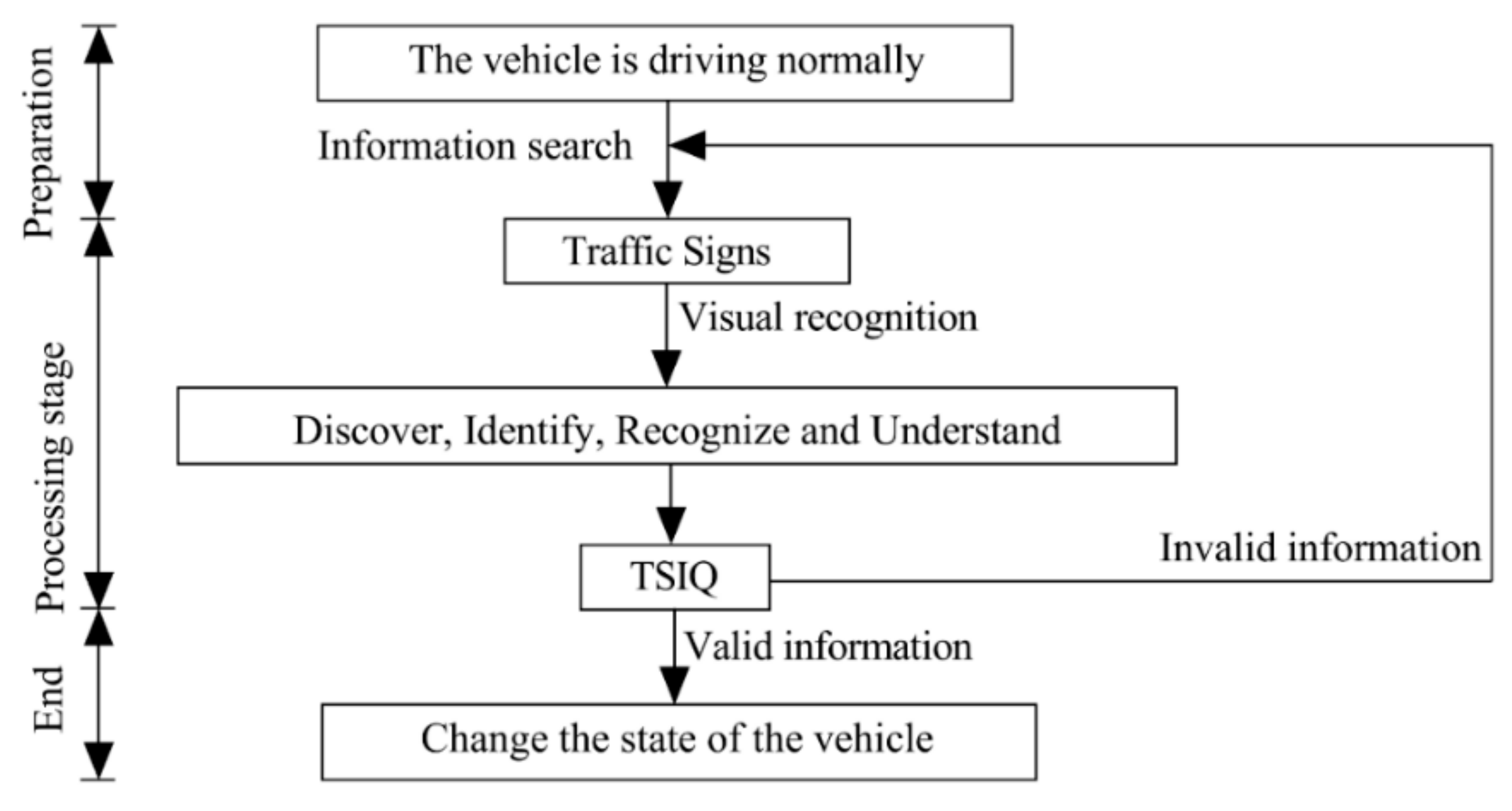
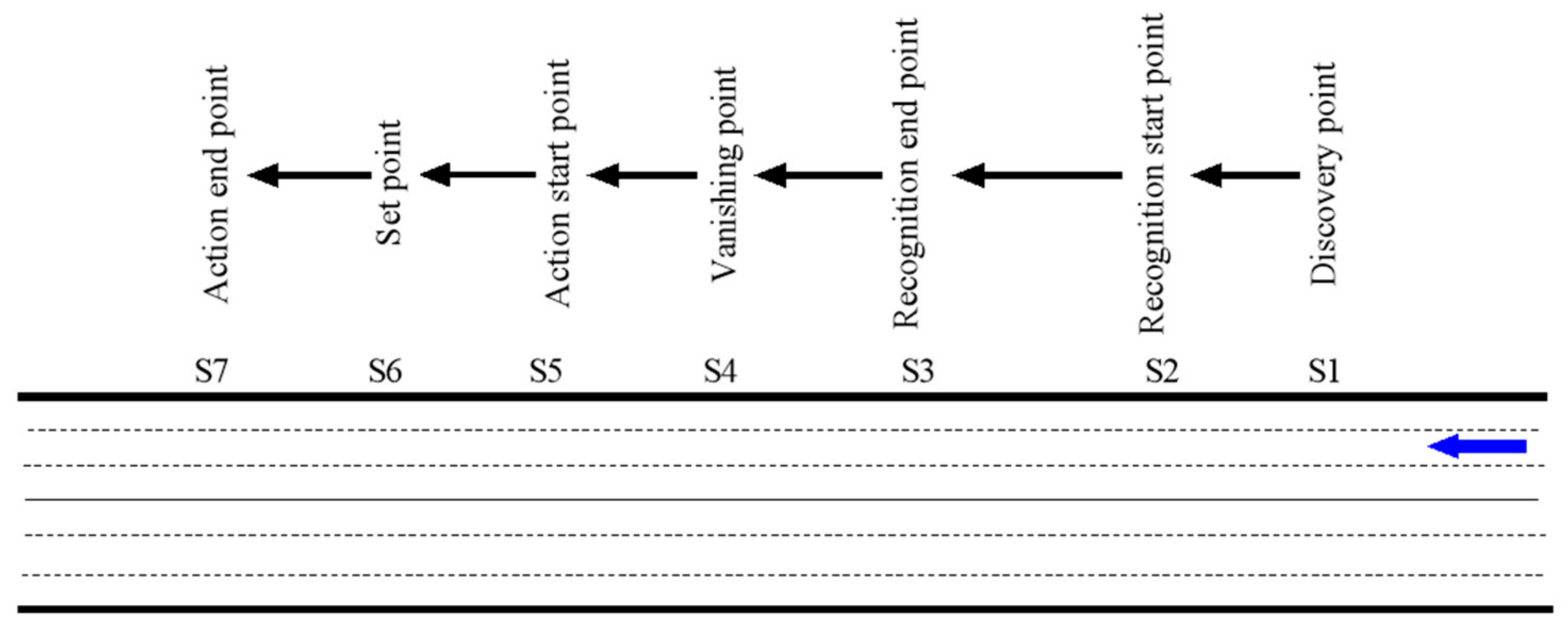
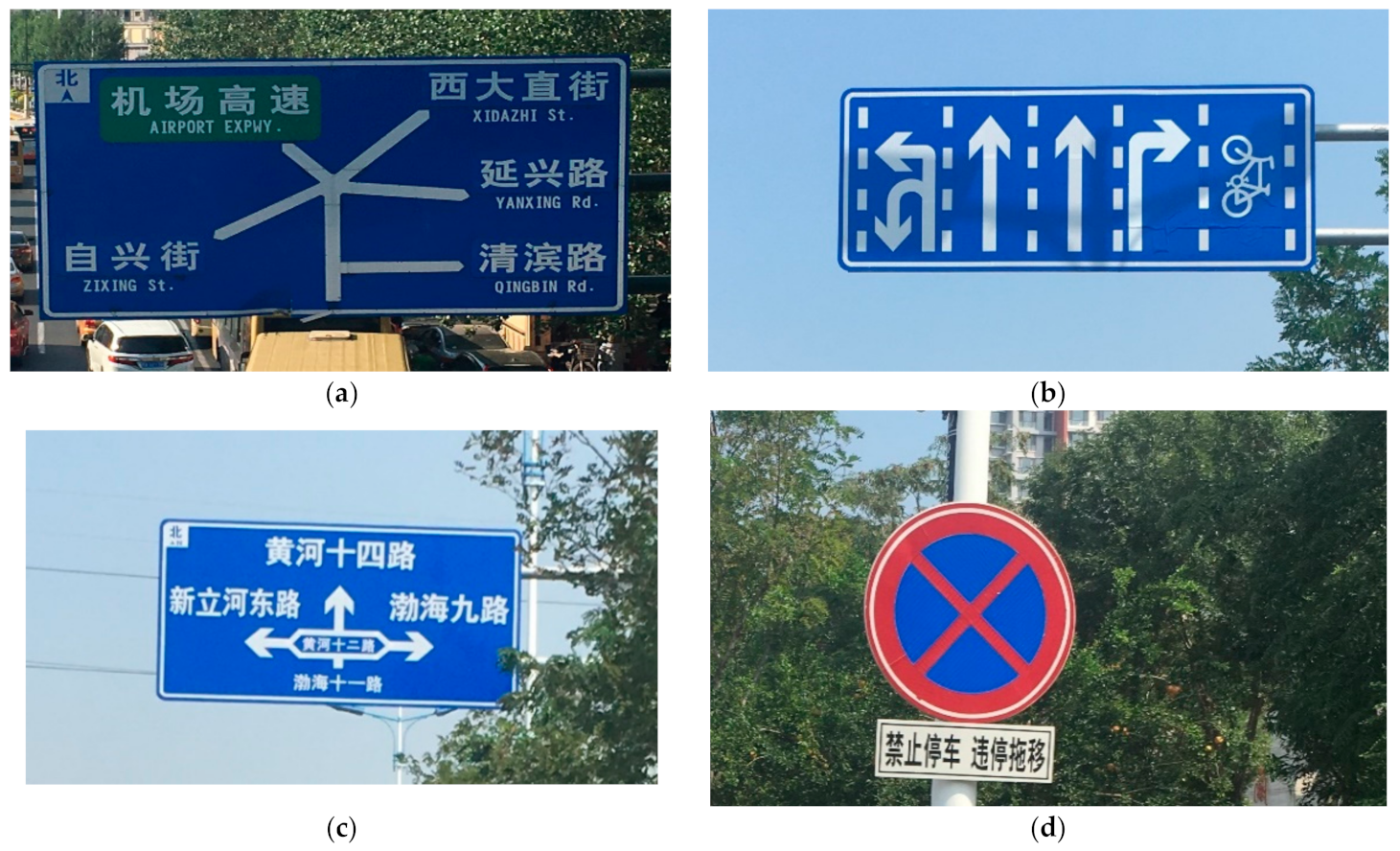
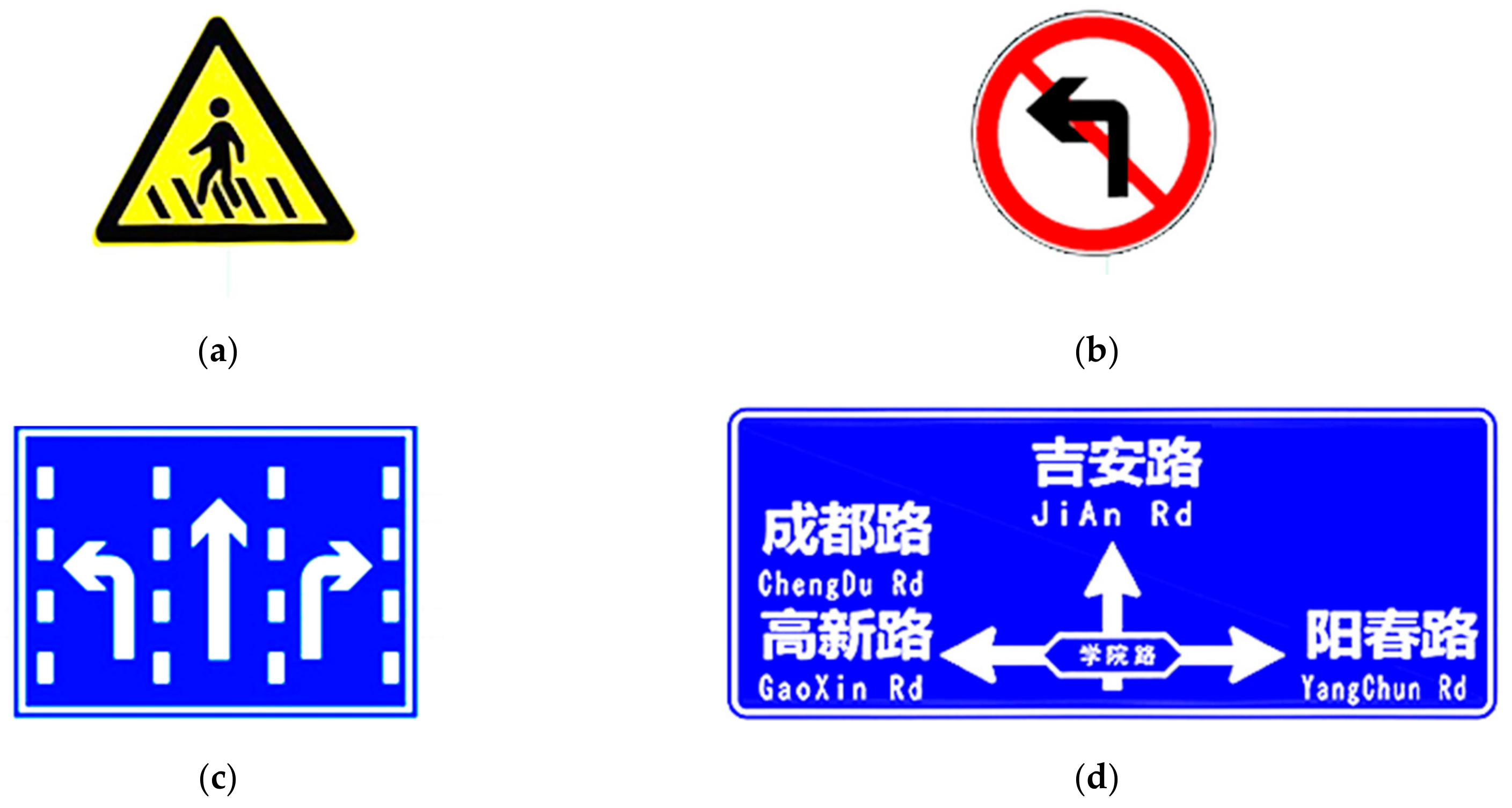
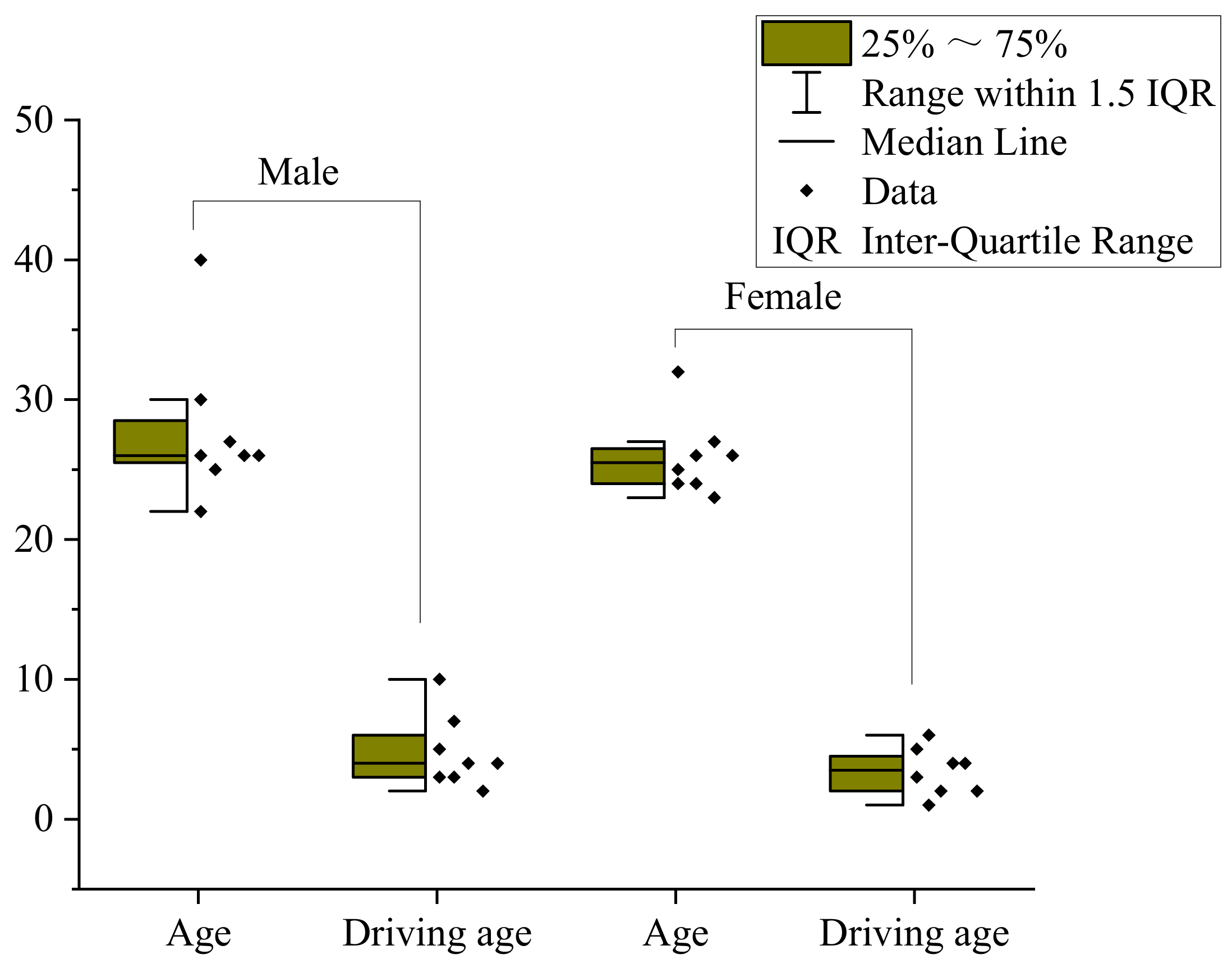
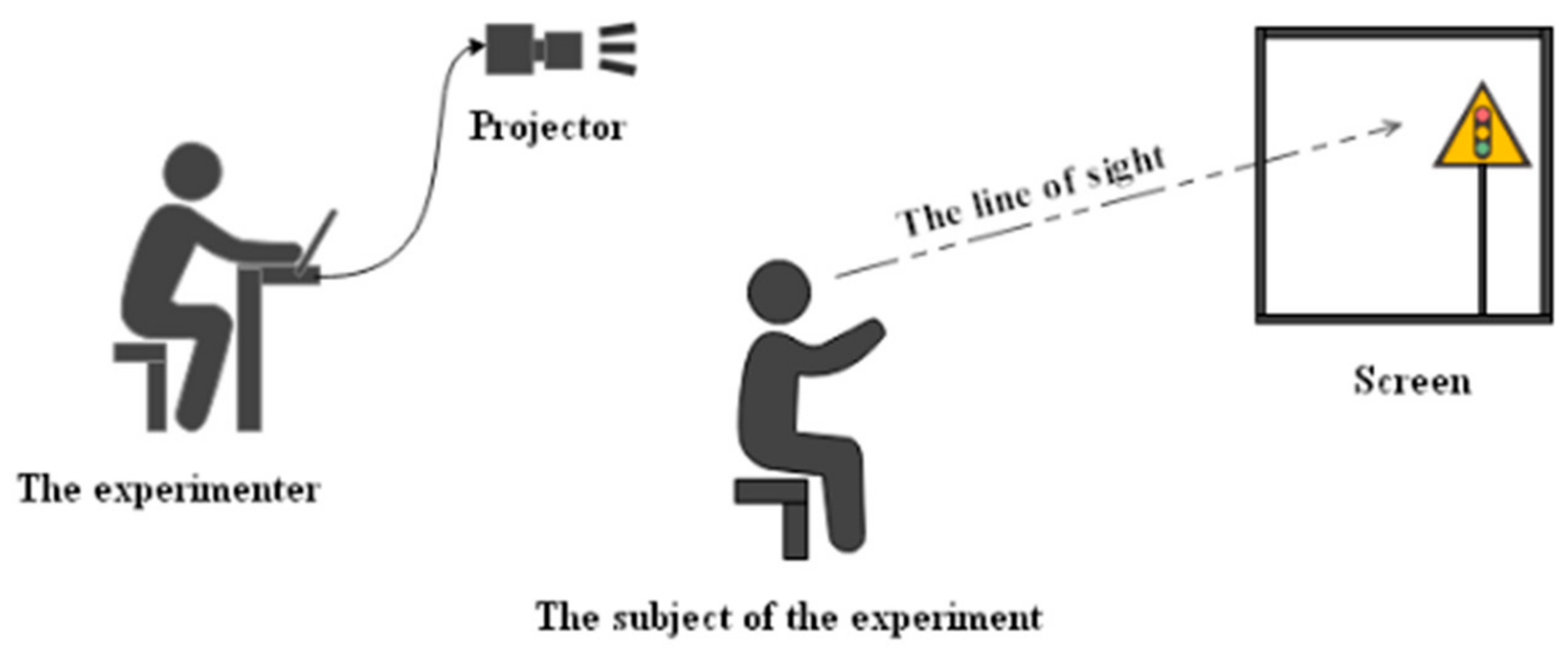

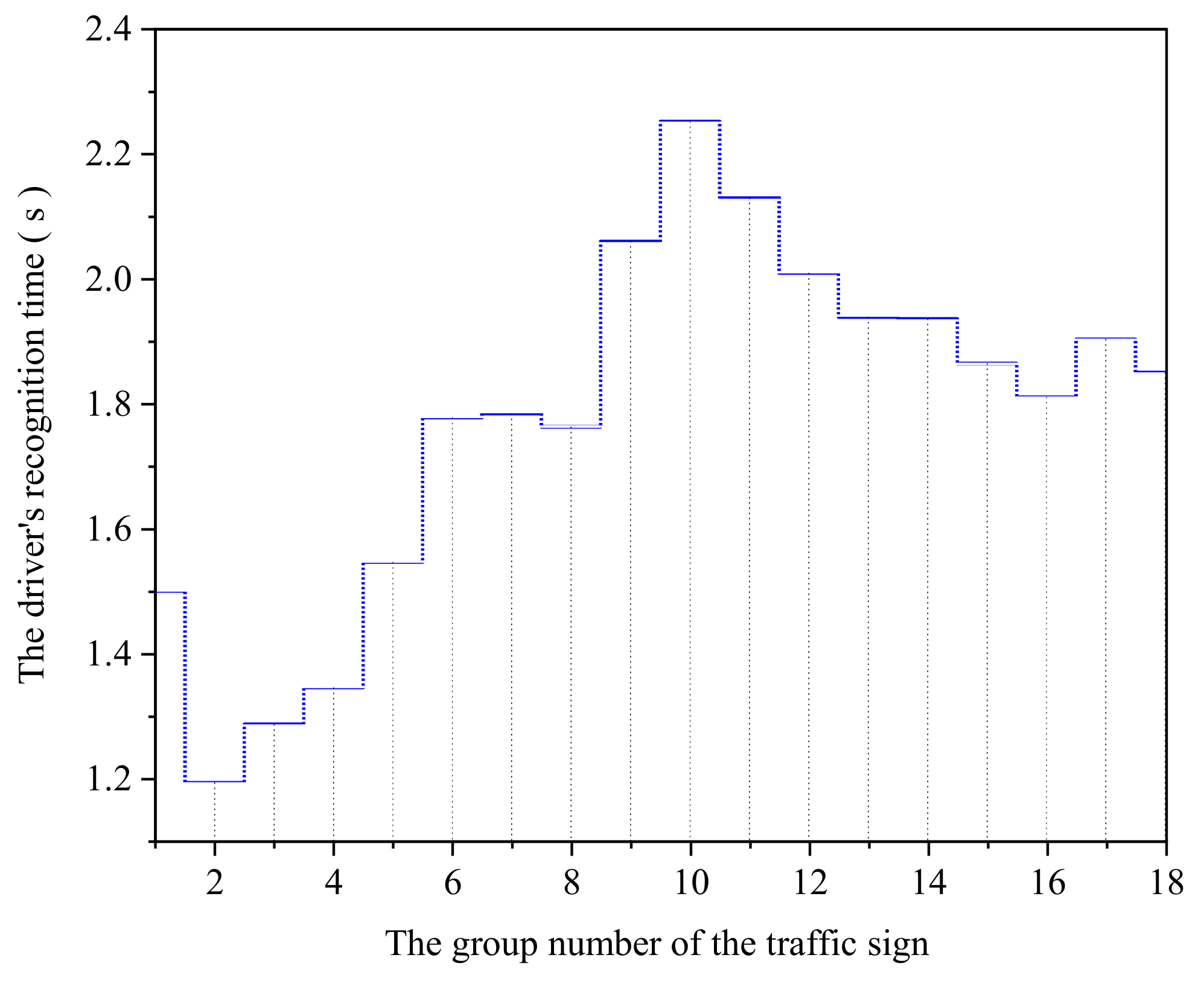


| The Serial Number | Type | N |
|---|---|---|
| 1 | Chinese character | 3500 |
| 2 | English character | 26 |
| 3 | Arabic numeral | 10 |
| 4 | Geometric figure | 6 |
| 5 | Color | 11 |
| 6 | Pointing symbol | 30 |
| 7 | Graphic or characteristic symbol | 50 |
| The Serial Number | Type | Information Quantity/Bits |
|---|---|---|
| 1 | Chinese character | 11.8 |
| 2 | English character | 4.7 |
| 3 | Arabic numeral | 3.3 |
| 4 | Geometric figure | 2.6 |
| 5 | Color | 3.5 |
| 6 | Pointing symbol | 4.9 |
| 7 | Graphics or characteristic symbol | 5.6 |
| Type | N | Pass Rate | Minimum/s | Maximum/s | Mean/s | Std. Deviation/s2 |
|---|---|---|---|---|---|---|
| DRT | 288 | 96.5% | 0.640 | 3.490 | 1.775 | 0.586 |
| Equation | Model Summary | ||
|---|---|---|---|
| R Square | F | Sig. | |
| Linear | 0.351 | 8.667 | 0.010 |
| Logarithmic | 0.520 | 17.335 | 0.001 |
| Quadratic | 0.620 | 12.249 | 0.001 |
| Cubic | 0.674 | 9.660 | 0.001 |
| Power | 0.511 | 16.741 | 0.001 |
| Exponential | 0.339 | 8.202 | 0.011 |
| Type | TSIQ’s Threshold Range/Bits | DRT’s Threshold Range/s |
|---|---|---|
| Excellent information | [0, 82] | [0, 1.9] |
| Suitable information | [82, 642] | [1.9, 3] |
| Information overload | [642, +∞) | [3, +∞) |
| TSIQ | Genders | Ages | Driving Ages | |||||
|---|---|---|---|---|---|---|---|---|
| Male | Female | [18, 25] | [26, 40] | [1, 3] | [4, 10] | |||
| 1 | ||||||||
| Genders | Male | 0.472 * | 1 | |||||
| Female | 0.616 ** | 0.755 ** | 1 | |||||
| Ages | [18, 25] | 0.555 * | 0.759 ** | 0.927 ** | 1 | |||
| [26, 40] | 0.588 * | 0.920 ** | 0.898 ** | 0.789 ** | 1 | |||
| Driving ages | [1, 3] | 0.551 * | 0.827 ** | 0.929 ** | 0.982 ** | 0.843 ** | 1 | |
| [4, 10] | 0.557 ** | 0.873 ** | 0.867 ** | 0.736 ** | 0.978 ** | 0.769 ** | 1 | |
| Name | Type | Mean/m | Std. Deviation/m2 | |
|---|---|---|---|---|
| VRD | Gender | Male Female | 93.371 95.512 | 3.516 7.233 |
| Ages | [18, 25] [26, 40] | 94.281 94.219 | 5.471 4.896 | |
| Driving ages | [1, 3] [4, 10] | 96.834 92.356 | 5.811 4.327 | |
Publisher’s Note: MDPI stays neutral with regard to jurisdictional claims in published maps and institutional affiliations. |
© 2021 by the authors. Licensee MDPI, Basel, Switzerland. This article is an open access article distributed under the terms and conditions of the Creative Commons Attribution (CC BY) license (https://creativecommons.org/licenses/by/4.0/).
Share and Cite
Liu, K.; Deng, H. The Relationship of the Information Quantity of Urban Roadside Traffic Signs and Drivers’ Visibility Based on Information Transmission. Int. J. Environ. Res. Public Health 2021, 18, 10976. https://doi.org/10.3390/ijerph182010976
Liu K, Deng H. The Relationship of the Information Quantity of Urban Roadside Traffic Signs and Drivers’ Visibility Based on Information Transmission. International Journal of Environmental Research and Public Health. 2021; 18(20):10976. https://doi.org/10.3390/ijerph182010976
Chicago/Turabian StyleLiu, Kun, and Hongxing Deng. 2021. "The Relationship of the Information Quantity of Urban Roadside Traffic Signs and Drivers’ Visibility Based on Information Transmission" International Journal of Environmental Research and Public Health 18, no. 20: 10976. https://doi.org/10.3390/ijerph182010976
APA StyleLiu, K., & Deng, H. (2021). The Relationship of the Information Quantity of Urban Roadside Traffic Signs and Drivers’ Visibility Based on Information Transmission. International Journal of Environmental Research and Public Health, 18(20), 10976. https://doi.org/10.3390/ijerph182010976






